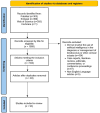Utility of artificial intelligence in the diagnosis and management of keratoconus: a systematic review
- PMID: 38984114
- PMCID: PMC11182163
- DOI: 10.3389/fopht.2024.1380701
Utility of artificial intelligence in the diagnosis and management of keratoconus: a systematic review
Abstract
Introduction: The application of artificial intelligence (AI) systems in ophthalmology is rapidly expanding. Early detection and management of keratoconus is important for preventing disease progression and the need for corneal transplant. We review studies regarding the utility of AI in the diagnosis and management of keratoconus and other corneal ectasias.
Methods: We conducted a systematic search for relevant original, English-language research studies in the PubMed, Web of Science, Embase, and Cochrane databases from inception to October 31, 2023, using a combination of the following keywords: artificial intelligence, deep learning, machine learning, keratoconus, and corneal ectasia. Case reports, literature reviews, conference proceedings, and editorials were excluded. We extracted the following data from each eligible study: type of AI, input used for training, output, ground truth or reference, dataset size, availability of algorithm/model, availability of dataset, and major study findings.
Results: Ninety-three original research studies were included in this review, with the date of publication ranging from 1994 to 2023. The majority of studies were regarding the use of AI in detecting keratoconus or subclinical keratoconus (n=61). Among studies regarding keratoconus diagnosis, the most common inputs were corneal topography, Scheimpflug-based corneal tomography, and anterior segment-optical coherence tomography. This review also summarized 16 original research studies regarding AI-based assessment of severity and clinical features, 7 studies regarding the prediction of disease progression, and 6 studies regarding the characterization of treatment response. There were only three studies regarding the use of AI in identifying susceptibility genes involved in the etiology and pathogenesis of keratoconus.
Discussion: Algorithms trained on Scheimpflug-based tomography seem promising tools for the early diagnosis of keratoconus that can be particularly applied in low-resource communities. Future studies could investigate the application of AI models trained on multimodal patient information for staging keratoconus severity and tracking disease progression.
Keywords: artificial intelligence; corneal ectasia; deep learning; keratoconus; machine learning.
Copyright © 2024 Goodman and Zhu.
Conflict of interest statement
The authors declare that the research was conducted in the absence of any commercial or financial relationships that could be construed as a potential conflict of interest.
Figures
Similar articles
-
Artificial intelligence in ophthalmology: opportunities, challenges, and ethical considerations.Med Hypothesis Discov Innov Ophthalmol. 2025 May 10;14(1):255-272. doi: 10.51329/mehdiophthal1517. eCollection 2025 Spring. Med Hypothesis Discov Innov Ophthalmol. 2025. PMID: 40453785 Free PMC article. Review.
-
Keratoconus: exploring fundamentals and future perspectives - a comprehensive systematic review.Ther Adv Ophthalmol. 2024 Mar 20;16:25158414241232258. doi: 10.1177/25158414241232258. eCollection 2024 Jan-Dec. Ther Adv Ophthalmol. 2024. PMID: 38516169 Free PMC article. Review.
-
Role of artificial intelligence, machine learning and deep learning models in corneal disorders - A narrative review.J Fr Ophtalmol. 2024 Sep;47(7):104242. doi: 10.1016/j.jfo.2024.104242. Epub 2024 Jul 15. J Fr Ophtalmol. 2024. PMID: 39013268 Review.
-
Patient selection for corneal topographic evaluation of keratoconus: A screening approach using artificial intelligence.Front Med (Lausanne). 2022 Aug 4;9:934865. doi: 10.3389/fmed.2022.934865. eCollection 2022. Front Med (Lausanne). 2022. PMID: 35991660 Free PMC article.
-
Machine Learning Algorithms to Detect Subclinical Keratoconus: Systematic Review.JMIR Med Inform. 2021 Dec 13;9(12):e27363. doi: 10.2196/27363. JMIR Med Inform. 2021. PMID: 34898463 Free PMC article. Review.
Cited by
-
Artificial intelligence in ophthalmology: opportunities, challenges, and ethical considerations.Med Hypothesis Discov Innov Ophthalmol. 2025 May 10;14(1):255-272. doi: 10.51329/mehdiophthal1517. eCollection 2025 Spring. Med Hypothesis Discov Innov Ophthalmol. 2025. PMID: 40453785 Free PMC article. Review.
-
Keratoconus: imaging modalities and management.Med Hypothesis Discov Innov Ophthalmol. 2024 Jul 1;13(1):44-54. doi: 10.51329/mehdiophthal1493. eCollection 2024. Med Hypothesis Discov Innov Ophthalmol. 2024. PMID: 38978828 Free PMC article. Review.
-
Evaluation of Responses to Questions About Keratoconus Using ChatGPT-4.0, Google Gemini and Microsoft Copilot: A Comparative Study of Large Language Models on Keratoconus.Eye Contact Lens. 2025 Mar 1;51(3):e107-e111. doi: 10.1097/ICL.0000000000001158. Epub 2024 Dec 4. Eye Contact Lens. 2025. PMID: 39629721 Free PMC article.
-
Strategies for Early Keratoconus Diagnosis: A Narrative Review of Evaluating Affordable and Effective Detection Techniques.J Clin Med. 2025 Jan 13;14(2):460. doi: 10.3390/jcm14020460. J Clin Med. 2025. PMID: 39860468 Free PMC article. Review.
-
Comparative analysis of large language models in providing patient information about keratoconus and contact lenses.Int Ophthalmol. 2025 Aug 18;45(1):340. doi: 10.1007/s10792-025-03711-2. Int Ophthalmol. 2025. PMID: 40824599
References
-
- Asimellis G, Kaufman EJ. Keratoconus. Treasure Island (FL: StatPearls Publishing Copyright © 2023, StatPearls Publishing LLC; (2023).
Publication types
LinkOut - more resources
Full Text Sources


